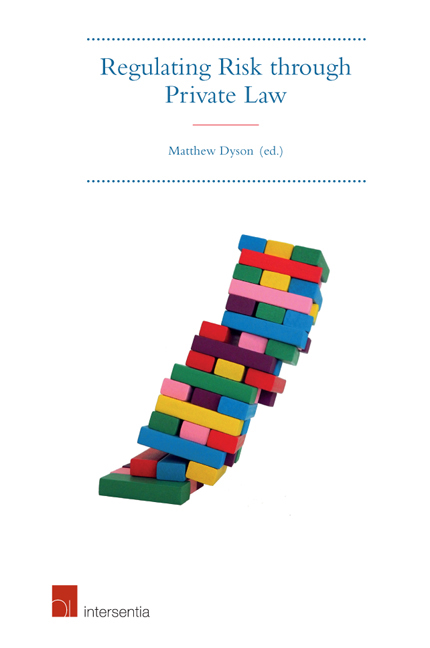Book contents
- Frontmatter
- Preface
- Contents
- Table of Cases
- List of Contributors
- Chapter 1 Introduction
- Part I Risk Overviews
- Chapter 2 Risk and english tort law
- Chapter 3 Risk and French Private Law
- Chapter 4 Risk in Swedish Tort Law: Of Models and Muddles
- Chapter 5 Risk and Italian Private Law
- Chapter 6 Regulating Risk Through Private Law: The Spanish Approach
- Chapter 7 How Dutch Tort Law Responds to Risks
- Chapter 8 Risk and Chilean Private Law
- Chapter 9 Regulating Risk Through Private Law: South Africa
- Chapter 10 Risk and Brazilian Private Law
- Part II State of the national art on risk
- Index
- About the Editor
Chapter 6 - Regulating Risk Through Private Law: The Spanish Approach
from Part I - Risk Overviews
Published online by Cambridge University Press: 13 October 2018
- Frontmatter
- Preface
- Contents
- Table of Cases
- List of Contributors
- Chapter 1 Introduction
- Part I Risk Overviews
- Chapter 2 Risk and english tort law
- Chapter 3 Risk and French Private Law
- Chapter 4 Risk in Swedish Tort Law: Of Models and Muddles
- Chapter 5 Risk and Italian Private Law
- Chapter 6 Regulating Risk Through Private Law: The Spanish Approach
- Chapter 7 How Dutch Tort Law Responds to Risks
- Chapter 8 Risk and Chilean Private Law
- Chapter 9 Regulating Risk Through Private Law: South Africa
- Chapter 10 Risk and Brazilian Private Law
- Part II State of the national art on risk
- Index
- About the Editor
Summary
INTRODUCTION
This chapter discusses how Spanish tort law regulates risk. The first part will deal with risk from a general perspective. As will be shown, risk (riesgo in Spanish) is one of the cornerstones of Spanish tort law. It is indeed impossible to understand how this tort law (responsabilidad extracontractual) has evolved during the last half-century and is currently shaped without making significant reference to the idea of risk. Therefore, this chapter will deal with the connections of risk with the general conditions of tort liability and will analyse how risk has infl uenced the judicial interpretation of tort law rules. Particular reference will also be made to some institutions or rules with regard to which risk plays a central role, namely development risks (riesgos del desarrollo), assumption of risk (asunci ó n del riesgo) and insurance.
SPANISH TORT LAW IN THE ‘RISK SOCIETY’
It may be interesting to note that, from a linguistic point of view, the English word ‘risk’ may have a Spanish origin.1 In fact, Spanish has two different words to refer to ‘risk’, namely peligro (danger) and riesgo (risk). Both of them are related to the Latin word periculum, and are therefore used interchangeably. The Latin root of riesgo (‘riesco’ in ancient Spanish) is resecare (‘to cut’), from which resecum (‘cutting’) also derives. There also seems to be some connection with another word, risco (a steep rock). According to the Royal Academy Dictionary, riesgo is the ‘contingency or proximity of damage’ and peligro means ‘ risk or imminent contingency that some evil takes place’. Riesgo is therefore any possible detrimental event that is capable of changing the normal and foreseeable course of an action or even unforeseeably altering a state of affairs.
Risk is a concept that permeates many areas of Spanish law. In contract law, it mainly refers to the possibility of the object of the contract becoming impossible. Such a situation may arise not only in contract – especially in sales – but also with regard to other types of obligations, as in the case of dowries, guardianship or legacies. In these contexts, the concept of risk refers to the question of who should bear the damage after the loss of a thing.
- Type
- Chapter
- Information
- Regulating Risk through Private Law , pp. 139 - 164Publisher: IntersentiaPrint publication year: 2018

